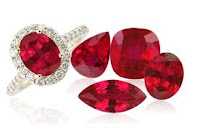Zircon's brilliance, beauty and luminescence can not be rivaled by most gems. It was once considered as the diamond's alternative. The mineral actually belongs to the group nesosilicates. Zircon probably got its name from the Arabic word "zarqun", which means "vermilion"; or from the Persian word "zargun", which means "golden colored".
Zircon Gemstone Information
Colors
The mineral is available in a wide range of colors. Zircon is colorless when it is pure, but it can also be blue, green, brown, yellow, orange, red, and all other colors in between. The most popular of zircons is that of the color yellow, also called hyacinth after the flower hyacinthus. Zircons are in general transparent to translucent in appearance. Some zircons are known to have that .cat.s eye effect., although quite rare.
Age
Zircon is among the most ancient minerals on Earth. A small fragment of Zircon was found in West Australia: It is roughly 4.4 billion years old. Even an older example is a discovered meteorite in Chile, which when examined, had fragments of the mineral for as old as 4.6 billion years old. Diamonds are fairly young compared to Zircons; they are only 3.3 billion years old.
Where Zircon is Found
The gemstone is quite remarkable, if only for its ubiquitous presence in the Earth's crust. It occurs in many geological processes; such as in igneous rocks, in metamorphic rocks, and in sedimentary rocks. Although fairly common, large zircon crystals are quite rare. Because of its uranium and thorium content, zircons self decay and self destruct after a specific amount of time. Zircons also played a significant role in the evolution of radiometric dating. Because of its uranium and thorium content, they can help pinpoint the exact date using many modern analytical techniques. Moreover, since the gemstones are able to withstand erosion, transport and metamorphism, they hold a rich and diverse documentation of geological processes. Now, Zircon is mined from various places around the world: Cambodia, Vietnam, Thailand, Sri Lanka, Nigeria, Tanzania, Brazil, and other countries.
Care
Zircon is brittle and sensitive to pressure; therefore it has the tendency to fray along its edges. On the other hand, the gemstone is incredibly durable. The mineral remains intact even under immense temperatures while other minerals begin to melt and reform during continental shifts and fierce asteroid impacts. Zircons should thus be stored and kept carefully because even though zircons are hard, their facets tend to graze and chip. Take care of your zircons carefully, clean them with mild soap, and use a toothbrush to brush on areas where dust is prone to collect.
Lore
Zircon is December's gemstone and the representation of the planet Pluto. During ancient times, zircons are believe to aid sleep, bring good fortune and promote honor to its wearers. A lose of color and luster of the gemstone warns the wearer that danger is near. It was used by shamans and healers for it was believed to have medicinal properties. Zircon is worn on the problem area of the body to aid in healing.
Natural Zircon
Nowadays, natural zircons are overlooked because of the discovery of cubic zirconia in 1937, a man made diamond imitation. Cubic Zirconias are laboratory grown, a compound of Zirconium, yttrium and oxygen. Though Cubic Zirconias are more common and more affordable, but they lack the luster and beauty of the natural zircons.




















